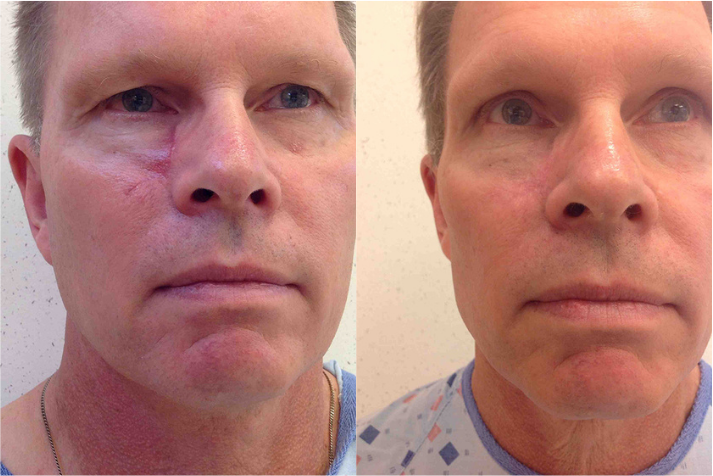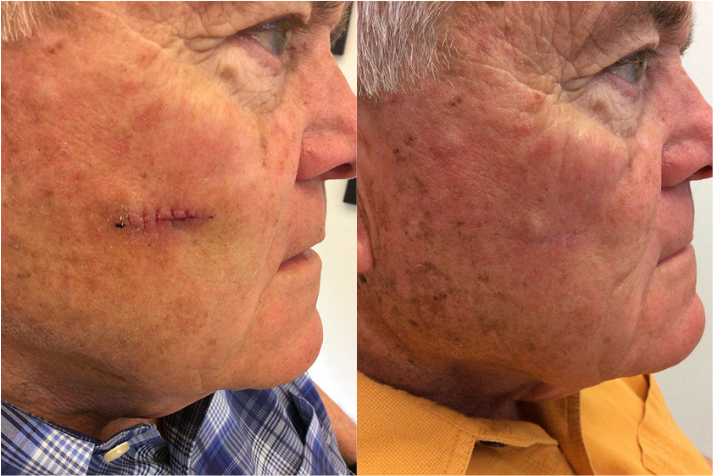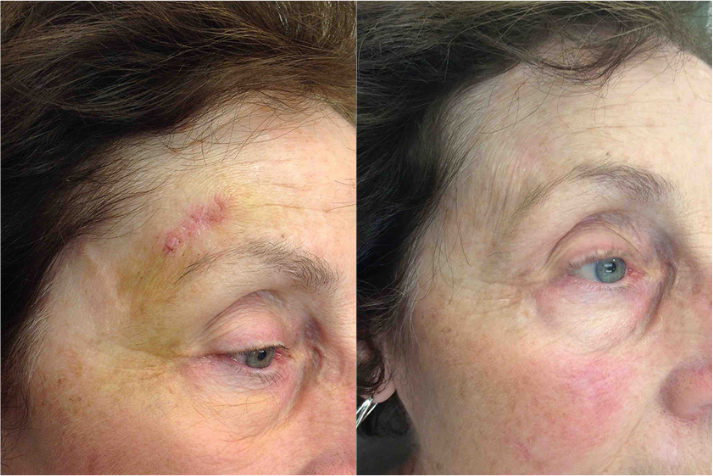A skin cancer diagnosis can feel overwhelming, but understanding your treatment options can help you make the best possible decision for your health. In the last few years, several companies have started advertising alternative treatments for common skin cancers, like basal cell carcinoma and squamous cell carcinoma, with superficial radiation therapy (SRT) and image-guided superficial radiation therapy (IG-SRT). While advertising on its own doesn’t indicate that a treatment is questionable, this one and the marketing behind it is concerning.
Radiation treatment for skin cancer may seem like an easy and less invasive option, but Mohs surgery still remains the gold standard for treatment of skin cancers on sensitive areas like the head and neck.
Dr. Joel Schlessinger, board-certified dermatologist, Mohs surgeon and cosmetic surgeon, explains, “When it comes to treating skin cancer, you might think that a “no-cut” approach like SRT would be easier, but I am still not convinced and am worried that, in many cases, it’s a more expensive and less effective option.”
He adds, “Mohs surgery allows us to prove in real time that we have eliminated all cancerous cells, with a greater than 99% cure rate, during the procedure. Unlike SRT and IG-SRT, it doesn’t scar the surrounding tissue or require multiple visits. The cure rates for these alternative treatments are surprisingly low in comparison and oftentimes, studies that are quoted, are short-term in nature, which means the results can’t be trusted.”
Looking to learn more about these different treatment options and if Mohs surgery is right for you? In this article, we’ll discuss:
What is Mohs surgery?
Mohs micrographic surgery is a specialized technique for removing skin cancer while preserving as much healthy tissue as possible. Unlike wide local excision surgical methods, in which a standard margin of normal skin is removed around the skin cancer, Mohs surgery involves the removal of skin cancer with the preservation of as much normal skin as possible, with each layer of skin carefully examined under a microscope in real time to ensure that all edges are free of cancer cells. This meticulous approach ensures all cancerous cells are removed while minimizing damage to surrounding healthy skin.
This technique is particularly beneficial for treating skin cancers in delicate areas, such as the face, ears, nose, hands and scalp. By removing only the necessary tissue, Mohs surgery reduces the risk of scarring and maintains the natural contours of your skin.
Dr. Daniel Schlessinger, board-certified dermatologist, Mohs surgeon and cosmetic surgeon, explains, “Mohs surgery has been around for nearly a century and has been perfected over this time to offer the best possible cure rate, up to 99% for certain skin cancers, while also sparing as much healthy skin as possible. This makes it especially effective when treating basal cell carcinoma, squamous cell carcinoma and a few other rarer forms of skin cancer.”
With board-certified dermatologists and Mohs surgeons like Drs. Joel and Daniel Schlessinger performing the procedure, patients can feel confident knowing they will receive expert care that only years of hands-on experience can provide.



How does Mohs compare to SRT and IG-SRT?
Superficial radiation therapy (SRT) and image-guided superficial radiation therapy (IG-SRT) use low-energy radiation to target and gradually breakdown cancerous cells over a series of treatments. While these therapies theoretically offer a way to avoid surgery, they do have many drawbacks you may want to consider before making your final decision:
- Lower cure rates: While Mohs surgery boasts a cure rate of up to 99%, radiation treatments are less effective with cure rates ranging from 80 to 90%, if even that. The studies that were done on SRT only looked at short-term follow-up (one to three years), whereas the studies done on Mohs surgery cure rates were much longer term. Many of the studies on superficial radiation are company-sponsored, which means they may have bias and incomplete or less-thorough methods of evaluation.
- Longer treatment process: SRT and IG-SRT usually require 18-25 treatment sessions over weeks to months, whereas Mohs surgery is typically done in one visit.
- Potential tissue damage: Radiation can cause skin thinning, damage and delayed healing, leading to potential scarring. If the cancer comes back later because it was incompletely treated (which often happens years later), the scar tissue from the radiation makes it much harder to treat and repair.
- Lack of real-time analysis: Unlike Mohs, radiation treatments do not provide any confirmation that any or all cancerous cells have been removed.
- Higher cost: Because SRT involves so many visits, the overall cost is usually much higher than the costs involved with Mohs surgery. This is often a part of the company’s advertisements to physicians who offer it, explaining that this will turn skin cancer into a much more profitable procedure.
- No confirmation of cure: Even though an SRT provider may claim it will “cure” your skin cancer, SRT does not check the margins or attempt in any way to prove that you are clear of skin cancer, as is done with Mohs surgery.
- No training required to perform SRT: Little, if any, training or board-certification is required in order to offer SRT. Mohs surgery, on the other hand, can only be performed by dermatologists who have gone through rigorous board certification, often involving a dedicated year-long fellowship training program.
Here’s a side-by-side breakdown to help guide your conversation with your dermatologist.
| Category | Mohs Micrographic Surgery | SRT (Superficial Radiation Therapy) |
| Number of visits | One (and possibly a second for suture removal) | 5–30 |
| Recurrence rates | Lowest (as low as 1%) | High (up to 15.8%) |
| Margin accuracy | Yes – margins are checked during surgery | No tissue testing |
| Expert opinion | First-line treatment | Second- and often third-line treatment |
| Training required | Requires board certification and fellowship | Does not require board certification or fellowship |
Dr. Joel Schlessinger explains, “With Mohs, we can see all the cancer has been removed before completing the surgery. While radiation treatments are useful and sometimes used alongside Mohs surgery, there’s no way to be certain all the cancer cells have been eliminated with SRT and IG-SRT, which can increase the risk of recurrence.”
He adds, “Over years of experience, dermatologists have defined when and how Mohs should be used. It isn’t used on all tumors, but in higher risk areas, it is consistently the best chance for cure.”
Why choose Mohs surgery?
With the highest cure rates and lowest recurrence risk, Mohs surgery is often considered the best option for treating common and uncommon skin cancers.
Dr. Daniel Schlessinger explains, “One of the biggest advantages of Mohs surgery is that it provides immediate results. Since each layer of tissue is examined in real time, patients leave their procedure knowing their skin cancer has been thoroughly treated.”
Additionally, Mohs surgery is completed in a single day, unlike radiation treatments which can require multiple sessions over several weeks.
Dr. Joel Schlessinger adds, “We do recommend radiation therapy as a good option for patients who are not candidates for surgery due to health concerns, but in a different style than these for-profit companies offer. Mohs remains the preferred choice whenever possible. Its effectiveness, precision and efficiency make it the best option for treating many types of skin cancer.”
At Schlessinger MD, our team of board-certified Mohs surgeons prioritizes patient care, offering the most advanced and effective treatments for skin cancer. We understand every diagnosis is personal, and we are committed to guiding you through your treatment options, creating a tailored path forward.
“Our goal is to provide the safest, most effective treatment while ensuring the best possible cosmetic outcome,” explains Dr. Joel Schlessinger. “Mohs surgery, when necessary, allows us to do exactly that. We also offer other methods, such as simple excision, chemical treatments and another method that involves cutting or gently scraping the tumor off and then cauterizing the surface.”
Additionally, Dr. Joel Schlessinger has been actively involved in multiple trials performing clinical research on skin cancer and its causes. He has done over twenty clinical trials on treatments for skin cancer or pre-skin cancer and has been active in this field for over 25 years. Dr. Daniel Schlessinger completed a rigorous fellowship in Mohs surgery at Northwestern University, and has completed over 4,000 cases during his career.
If you have been diagnosed with skin cancer and are considering your treatment options, we’re here to help. Schedule a one-on-one consultation with Drs. Joel or Daniel Schlessinger today to learn more.